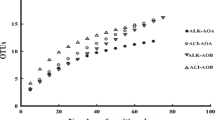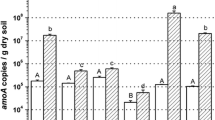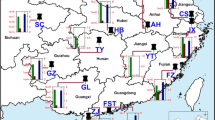Abstract
Purpose
Ammonia oxidation plays an important role in global nitrogen cycle. However, little information is available on ammonia oxidizers in paddy soils. This study aimed to understand the controlling factors of ammonia oxidizers in the paddy soils.
Materials and methods
Three types of paddy soils were collected from southwest [Chongqing City (CQ)], central [Honghu City (HH)], and northeast [Panjin City (PJ)] of China, respectively. The soils were cultured with unplanted and rice-planted pot experiments for 10 weeks. The abundance and composition of ammonia-oxidizing bacteria (AOB) and ammonia-oxidizing archaea (AOA) of the paddy soil samples were investigated by real-time polymerase chain reaction and denaturing gradient gel electrophoresis approaches based on amoA genes.
Results and discussion
In this study, minor changes in the abundance and community structure of both AOB and AOA were observed among the treatments of unplanted and rhizosphere and bulk of rice-planted soil samples in the same type of paddy soil. The AOB population sizes in CQ were lower than those in HH and PJ, while the AOA in CQ and HH were lower than those in PJ. The amoA gene copy numbers of AOA were more abundant than those of AOB in all treatments of the three paddy soils. The community structure of both AOB and AOA in all paddy soils was different from each other.
Conclusions
The population size and community structure of AOB and AOA in the flooded paddy soils were mainly determined by the soil types, irrespective of rice-planted or unplanted.



Similar content being viewed by others
References
Beman JM, Francis CA (2006) Diversity of ammonia-oxidizing Archaea and bacteria in the sediments of a hypernutrified subtropical estuary: Bahiìa del Toìbari, Mexico. Appl Environ Microbiol 72:7767–7777
Chen XP, Zhu YG, Xia Y, Shen JP, He JZ (2008) Ammonia-oxidizing Archaea: important players in paddy rhizosphere soil? Environ Microbiol 10:1978–1987
Di HJ, Cameron KC, Shen JP, Winefield CS, O’Callaghan M, Bowatte S, He JZ (2009) Nitrification driven by bacteria and not Archaea in nitrogen-rich grassland soils. Nature Geosci 2:621–624
Di HJ, Cameron KC, Shen JP, Winefield CS, O’Callaghan M, Bowatte S, He JZ (2010) Ammonia-oxidizing bacteria and Archaea grow under contrasting soil nitrogen conditions. FEMS Microbiol Ecol 72:386–394
Francis CA, Roberts KJ, Beman JM, Santoro AE, Oakley BB (2005) Ubiquity and diversity of ammonia-oxidizing Archaea in water columns and sediments of the ocean. Proc Natl Acad Sci USA 102:14683–14688
Ge Y, He JZ, Zhu YG, Zhang JB, Xu ZH, Zhang LM, Zheng YM (2008) Differences in soil bacterial diversity: driven by contemporary disturbances or historical contingencies? ISME J 2:254–264
Girvan MS, Bullimore J, Pretty JN, Osborn AM, Ball AS (2003) Soil type is the primary determinant of the composition of the total and active bacterial communities in arable soils. Appl Environ Microbiol 69:1800–1809
He JZ, Shen JP, Zhang LM, Zhu YG, Zheng YM, Xu MG, Di HJ (2007) Quantitative analyses of the abundance and composition of ammonia-oxidizing bacteria and ammonia-oxidizing Archaea of a Chinese upland red soil under long-term fertilization practices. Environ Microbiol 9:2364–2374
Könneke M, Bernhard AE, de la Torre JR, Walker CB, Waterbury JB, Stahl DA (2005) Isolation of an autotrophic ammonia-oxidizing marine archaeon. Nature 437:43–546
Lam P, Jensen MM, Lavik G, McGinnis DF, Muller B, Schubert CJ, Amann R, Thamdrup B, Kuypers MMM (2007) Linking crenarchaeal and bacterial nitrification to anammox in the Black Sea. Proc Natl Acad Sci USA 104:7104–7109
Leininger S, Urich T, Schloter M, Schwark L, Qi J, Nicol GW, Prosser JI, Schuster SC, Schleper C (2006) Archaea predominate among ammonia-oxidizing prokaryotes in soils. Nature 442:806–809
Mincer TJ, Church MJ, Taylor LT, Preston C, Kar DM, DeLong EF (2007) Quantitative distribution of presumptive Archaeal and bacterial nitrifiers in Monterey Bay and the North Pacific Subtropical Gyre. Environ Microbiol 9:1162–1175
Mosier AC, Francis CA (2008) Relative abundance and diversity of ammonia-oxidizing Archaea and bacteria in the San Francisco Bay estuary. Environ Microbiol 10:3002–3016
Nicolaisen MH, Risgaard-Petersen N, Revsbech NP, Reichardt W, Ramsing NB (2004) Nitrification-denitrification dynamics and community structure of ammonia oxidizing bacteria in a high yield irrigated Philippine rice field. FEMS Microbiol Ecol 49:359–369
Park HD, Wells GF, Bae H, Criddle CS, Francis CA (2006) Occurrence of ammonia-oxidizing Archaea in wastewater treatment plant bioreactors. Appl Environ Microbiol 72:5643–5647
Prosser JI (1989) Autotrophic nitrification in bacteria. Adv Microb Physiol 30:125–181
Revsbech NP, Pedersen O, Reichardt W, Briones A (1999) Microsensor analysis of oxygen and pH in the rice rhizosphere under field and laboratory conditions. Biol Fertil Soils 29:379–385
Rotthauwe JH, Witzel KP, Liesack W (1997) The ammonia monooxygenase structural gene amoA as a functional marker: molecular fine-scale analysis of natural ammonia-oxidizing populations. Appl Environ Microbiol 63:4704–4712
Santoro AE, Francis CA, de Sieyes NR, Boehm AB (2008) Shifts in the relative abundance of ammonia-oxidizing bacteria and Archaea across physicochemical gradients in a subterranean estuary. Environ Microbiol 10:1068–1079
Schauss K, Focks A, Leininger S, Kotzerke A, Heuer H, Thiele-Bruhn S, Sharma S, Wilke BM, Matthies M, Smalla K, Munch JC, Amelung W, Kaupenjohann M, Schloter M, Schleper C (2009) Dynamics and functional relevance of ammonia-oxidizing Archaea in two agricultural soils. Environ Microbiol 11:446–456
Shen JP, Zhang LM, Zhu YG, Zhang JB, He JZ (2008) Abundance and composition of ammonia-oxidizing bacteria and ammonia-oxidizing Archaea communities of an alkaline sandy loam. Environ Microbiol 10:1601–1611
Treusch AH, Leininger S, Kletzin A, Schuster SC, Klenk HP, Schleper C (2005) Novel genes for nitrite reductase and Amo-related proteins indicate a role of uncultivated mesophilic Crenarchaeota in nitrogen cycling. Environ Microbiol 7:1985–1995
Venter JC, Remington K, Heidelberg JF, Halpern AL, Rusch D, Eisen JA, Wu DY, Paulsen I, Nelson KE, Nelson W, Fouts DE, Levy S, Knap AH, Lomas MW, Nealson K, White O, Peterson J, Hoffman J, Parsons R, Baden-Tillson H, Pfannkoch C, Rogers YH, Smith HO (2004) Environmental genome shotgun sequencing of the Sargasso Sea. Science 304:66–74
Wang YA, Ke XB, Wu LQ, Lu YH (2009) Community composition of ammonia-oxidizing bacteria and Archaea in rice field soil as affected by nitrogen fertilization. Syst Appl Microbiol 32:27–36
Weidler GW, Dornmayr-Pfaffenhuemer M, Gerbl FW, Heinen W, Stan-Lotter H (2007) Communities of Archaea and bacteria in a subsurface radioactive thermal spring in the Austrian Central Alps, and evidence of ammonia-oxidizing Crenarchaeota. Appl Environ Microbiol 73:259–270
Wuchter C, Abbas B, Coolen MJL, Herfort L, Van Bleijswijk J, Timmers P, Strous M, Teira E, Herndl GJ, Middelburg JJ, Schouten S, Damste JSS (2006) Archaeal nitrification in the ocean. Proc Natl Acad Sci USA 103:12317–12322
Yang CH, Crowley DE (2000) Rhizosphere microbial community structure in relation to root location and plant iron nutrition status. Appl Environ Microbiol 66:345–351
Ying JY, Zhang LM, He JZ (2010) Putative ammonia-oxidizing bacteria and Archaea in an acidic red soil with different land utilization patterns. Environ Microbiol Reports 2:304–312
Yuan F, Ran W, Shen QR, Wang DZ (2005) Characterization of nitrifying bacteria communities of soils from different ecological regions of China by molecular and conventional methods. Biol Fertil Soils 41:22–27
Zhang LM, Wang M, Prosser JI, Zheng YM, He JZ (2009) Altitude ammonia-oxidizing bacteria and Archaea in soils of Mount Everest. FEMS Microbiol Ecol 70:208–217
Acknowledgements
This work was supported by the National Basic Research Program of China (2005CB121105) and the Natural Science Foundation of China (40871129, 50921064).
Author information
Authors and Affiliations
Corresponding author
Additional information
Responsible editor: Hailong Wang
Rights and permissions
About this article
Cite this article
Chen, X., Zhang, LM., Shen, JP. et al. Soil type determines the abundance and community structure of ammonia-oxidizing bacteria and archaea in flooded paddy soils. J Soils Sediments 10, 1510–1516 (2010). https://doi.org/10.1007/s11368-010-0256-9
Received:
Accepted:
Published:
Issue Date:
DOI: https://doi.org/10.1007/s11368-010-0256-9




